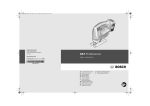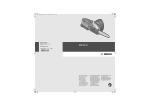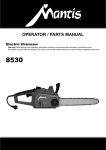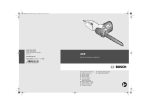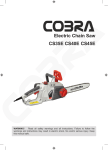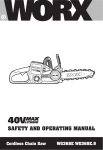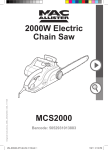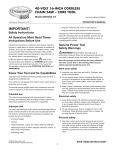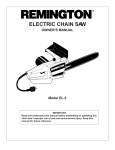Download Bosch Ake 40-19 S Operating instructions
Transcript
OBJ_DOKU-21946-001.fm Page 1 Monday, May 3, 2010 2:01 PM Robert Bosch GmbH Power Tools Division 70745 Leinfelden-Echterdingen Germany www.bosch-pt.com F 016 L70 667 (2010.04) O / 217 WEU AKE 30-19 S | 35-19 S | 40-19 S de en fr es pt it nl Originalbetriebsanleitung Original instructions Notice originale Manual original Manual original Istruzioni originali Oorspronkelijke gebruiksaanwijzing da Original brugsanvisning sv Bruksanvisning i original no Original driftsinstruks fi Alkuperäiset ohjeet el Πρωτότυπο οδηγιών χρήσης tr Orijinal işletme talimat OBJ_BUCH-1238-001.book Page 3 Friday, April 30, 2010 9:39 AM 3| Robert Bosch GmbH D-70745 Leinfelden Echterdingen 0 600 xxx xxx xxx V ~ xx Hz x A xxxx W 1 2 AKE 40-19 S 3 4 5 6 7 16 15 14 13 12 11 10 A xxx xxx mm xxxxxxxx X 20xx Made in XXX 8 9 17 18 17 19 22 25 20 21 24 23 F 016 L70 667 | (30.4.10) 12 Bosch Power Tools OBJ_BUCH-1238-001.book Page 4 Friday, April 30, 2010 9:39 AM 4| B 26 4 3 2 27 C 3-4 mm 14 15 D 5 13 28 13 F 016 L70 667 | (30.4.10) Bosch Power Tools OBJ_BUCH-1238-001.book Page 5 Friday, April 30, 2010 9:39 AM 5| E F G H I J 50 mm X Y Z W 50 mm F 016 L70 667 | (30.4.10) 29 Bosch Power Tools OBJ_BUCH-1238-001.book Page 6 Friday, April 30, 2010 9:39 AM 6| K L M 1 1/3 2 2/3 N O 2 1 2/3 1/3 F 016 L70 667 | (30.4.10) Bosch Power Tools OBJ_BUCH-1238-001.book Page 24 Friday, April 30, 2010 9:39 AM 24 | English Safety Notes en Explanation of symbols Read all safety warnings and all instructions. Failure to follow the warnings and instructions may result in electric shock, fire and/or serious injury. Remove the plug from the socket or mains immediately before carrying out any adjustments, servicing or maintenance or if the cable is damaged or cut. Do not use the machine in the rain or leave it outdoors when it is raining. Obtain and wear eye and ear protection at all times while operating the power tool. The kickback brake and the run-down brake stop the chain saw within short time. General Power Tool Safety Warnings WARNING Read all safety warnings and all instructions. Failure to follow the warnings and instructions may result in electric shock, fire and/or serious injury. Save all warnings and instructions for future reference. The term “power tool” in the warnings refers to your mains-operated (corded) power tool or battery-operated (cordless) power tool. 1) Work area safety a) Keep work area clean and well lit. Cluttered or dark areas invite accidents. b) Do not operate power tools in explosive atmospheres, such as in the presence of flammable liquids, gases or dust. Power tools create sparks which may ignite the dust or fumes. c) Keep children and bystanders away while operating a power tool. Distractions can cause you to lose control. F 016 L70 667 | (30.4.10) 2) Electrical safety a) Power tool plugs must match the outlet. Never modify the plug in any way. Do not use any adapter plugs with earthed (grounded) power tools. Unmodified plugs and matching outlets will reduce risk of electric shock. b) Avoid body contact with earthed or grounded surfaces, such as pipes, radiators, ranges and refrigerators. There is an increased risk of electric shock if your body is earthed or grounded. c) Do not expose power tools to rain or wet conditions. Water entering a power tool will increase the risk of electric shock. d) Do not abuse the cord. Never use the cord for carrying, pulling or unplugging the power tool. Keep cord away from heat, oil, sharp edges and moving parts. Damaged or entangled cords increase the risk of electric shock. e) When operating a power tool outdoors, use an extension cord suitable for outdoor use. Use of a cord suitable for outdoor use reduces the risk of electric shock. f) If operating a power tool in a damp location is unavoidable, use a residual current device (RCD) protected supply. Use of an RCD reduces the risk of electric shock. 3) Personal safety a) Stay alert, watch what you are doing and use common sense when operating a power tool. Do not use a power tool while you are tired or under the influence of drugs, alcohol or medication. A moment of inattention while operating power tools may result in serious personal injury. b) Use personal protective equipment. Always wear eye protection. Protective equipment such as dust mask, non-skid safety shoes, hard hat, or hearing protection used for appropriate conditions will reduce personal injuries. Bosch Power Tools OBJ_BUCH-1238-001.book Page 25 Friday, April 30, 2010 9:39 AM English | 25 c) Prevent unintentional starting. Ensure the switch is in the off-position before connecting to power source and/or battery pack, picking up or carrying the tool. Carrying power tools with your finger on the switch or energising power tools that have the switch on invites accidents. d) Store idle power tools out of the reach of children and do not allow persons unfamiliar with the power tool or these instructions to operate the power tool. Power tools are dangerous in the hands of untrained users. d) Remove any adjusting key or wrench before turning the power tool on. A wrench or a key left attached to a rotating part of the power tool may result in personal injury. e) Maintain power tools. Check for misalignment or binding of moving parts, breakage of parts and any other condition that may affect the power tool’s operation. If damaged, have the power tool repaired before use. Many accidents are caused by poorly maintained power tools. e) Do not overreach. Keep proper footing and balance at all times. This enables better control of the power tool in unexpected situations. f) Keep cutting tools sharp and clean. Properly maintained cutting tools with sharp cutting edges are less likely to bind and are easier to control. f) Dress properly. Do not wear loose clothing or jewellery. Keep your hair, clothing and gloves away from moving parts. Loose clothes, jewellery or long hair can be caught in moving parts. g) Use the power tool, accessories and tool bits etc. in accordance with these instructions, taking into account the working conditions and the work to be performed. Use of the power tool for operations different from those intended could result in a hazardous situation. g) If devices are provided for the connection of dust extraction and collection facilities, ensure these are connected and properly used. Use of dust collection can reduce dust-related hazards. 4) Power tool use and care a) Do not force the power tool. Use the correct power tool for your application. The correct power tool will do the job better and safer at the rate for which it was designed. 5) Service a) Have your power tool serviced by a qualified repair person using only identical replacement parts. This will ensure that the safety of the power tool is maintained. Chain Saw Safety Warnings b) Do not use the power tool if the switch does not turn it on and off. Any power tool that cannot be controlled with the switch is dangerous and must be repaired. f Keep all parts of the body away from the saw chain when the motor is operating. Before you start the chain saw, make sure the saw chain is not contacting anything. A moment of inattention while operating chain saws may cause entanglement of your clothing or body with the saw chain. c) Disconnect the plug from the power source and/or the battery pack from the power tool before making any adjustments, changing accessories, or storing power tools. Such preventive safety measures reduce the risk of starting the power tool accidentally. f Hold the power tool by insulated gripping surfaces only, because the saw chain may contact hidden wiring or its own cord. Saw chains contacting a “live” wire may make exposed metal parts of the power tool “live” and could give the operator an electric shock. Bosch Power Tools F 016 L70 667 | (30.4.10) OBJ_BUCH-1238-001.book Page 26 Friday, April 30, 2010 9:39 AM 26 | English f Always hold the chain saw with your right hand on the rear handle and your left hand on the front handle. Holding the chain saw with a reversed hand configuration increases the risk of personal injury and should never be done. f Wear safety glasses and hearing protection. Further protective equipment for head, hands, legs and feet is recommended. Adequate protective clothing will reduce personal injury by flying debris or accidental contact with the saw chain. f Do not operate a chain saw in a tree. Operation of a chain saw while up in a tree may result in personal injury. f Always keep proper footing and operate the chain saw only when standing on fixed, secure and level surface. Slippery or unstable surfaces such as ladders may cause a loss of balance or control of the chain saw. f When cutting a limb that is under tension be alert for spring back. When the tension in the wood fibres is released the spring loaded limb may strike the operator and/or throw the chain saw out of control. f Use extreme caution when cutting brush and saplings. The slender material may catch the saw chain and be whipped toward you or pull you off balance. f Carry the chain saw by the front handle with the chain saw switched off and away from your body. When transporting or storing the chain saw, always fit the guide bar cover. Proper handling of the chain saw will reduce the likelihood of accidental contact with the moving saw chain. f Follow instructions for lubricating, chain tensioning and changing accessories. Improperly tensioned or lubricated chain may either break or increase the chance for kickback. f Keep handles dry, clean, and free from oil and grease. Greasy, oily handles are slippery causing loss of control. f Cut wood only. Don’t use chain saw for purposes not intended. For example: do not use chain saw for cutting plastic, masonry or non-wood building materials. Use of the chain saw for operations different than intended could result in a hazardous situation. F 016 L70 667 | (30.4.10) Causes and operator prevention of kickback: – Kickback may occur when the nose or tip of the guide bar touches an object, or when the wood closes in and pinches the saw chain in the cut. – Tip contact in some cases may cause a sudden reverse reaction, kicking the guide bar up and back towards the operator. – Pinching the saw chain along the top of the guide bar may push the guide bar rapidly back towards the operator. – Either of these reactions may cause you to lose control of the saw which could result in serious personal injury. Do not rely exclusively upon the safety devices built into your saw. As a chain saw user, you should take several steps to keep your cutting jobs free from accident or injury. Kickback is the result of tool misuse and/or incorrect operating procedures or conditions and can be avoided by taking proper precautions as given below: f Maintain a firm grip, with thumbs and fingers encircling the chain saw handles, with both hands on the saw and position your body and arm to allow you to resist kickback forces. Kickback forces can be controlled by the operator, if proper precautions are taken. Do not let go of the chain saw. f Do not overreach and do not cut above shoulder height. This helps prevent unintended tip contact and enables better control of the chain saw in unexpected situations. f Only use replacement bars and chains specified by the manufacturer. Incorrect replacement bars and chains may cause chain breakage and/or kickback. f Follow the manufacturer’s sharpening and maintenance instructions for the saw chain. Decreasing the depth gauge height can lead to increased kickback. f Children and juveniles, with the exception of apprentices older than 16 years and under supervision, may not operate the chain saw. The same applies for persons who do not or do not sufficiently know how to handle the chain saw. The operating instructions should always be ready to hand. Persons unfit or tired must not operate the chain saw. Bosch Power Tools OBJ_BUCH-1238-001.book Page 27 Friday, April 30, 2010 9:39 AM English | 27 f Always ensure all handles and guards are fitted when using the machine. Never attempt to use an incomplete machine or one fitted with an unauthorized modification. It is recommended that the first time user should have practical instruction in the use of the chainsaw and the protective equipment from an experienced operator. The initial practice should be cutting logs on a saw horse or cradle. f Always wait until the machine has come to a complete stop before placing it down. The tool insert can jam and lead to loss of control over the power tool. f Never use the machine with a damaged cable. Do not touch the damaged cable and pull the mains plug when the cable is damaged while working. Damaged cables increase the risk of an electric shock. Functional Description Read all safety warnings and all instructions. Failure to follow the warnings and instructions may result in electric shock, fire and/or serious injury. Intended Use The power tool is intended for sawing wood such as wooden beams, planks, branches, tree trunks, etc., and for sawing of trees. Cuts can be sawed with or across the grain. This power tool is not suitable for sawing mineral materials. Delivery Scope Carefully remove the machine from its packaging and check if the following parts are complete: – – – – – Chain saw Cover Chain Chain bar Chain guard Bosch Power Tools – Saw chain oil (80 ml) – Operating instructions When parts are missing or damaged, please contact your dealer. Product Features The numbering of the product features refers to the illustration of the machine on the graphics page. 1 2 3 4 5 6 7 8 9 10 11 12 13 14 15 16 17 18 19 20 21 22 23 24 25 26 27 28 29 Rear handle On/Off switch Lock-off button for On/Off switch Oil filler cap Activation lever for kickback brake (hand guard) Deactivation mark “for kickback brake” Front handle Serial number Nose sprocket (AKE 35-19 S/AKE 40-19 S) Chain guard Saw chain Chain bar Gripping teeth Chain-tensioning ring (red) Locking knob Cover Symbol for rotation and cutting direction Drive sprocket Oil outlet Guide fin for chain bar Fastening bolt Chain catch bolt Chain tensioning catch Power plug** Extension cable* Oil level gauge Ventilation slots Red dot Protective lid of chain-tensioning mechanism ** country specific *Accessories shown or described are not part of the standard delivery scope of the product. A complete overview of accessories can be found in our accessories program. F 016 L70 667 | (30.4.10) OBJ_BUCH-1238-001.book Page 28 Friday, April 30, 2010 9:39 AM 28 | English Technical Data Chain saw AKE 40-19 S 3 600 H36 D.. 3 600 H36 E.. 3 600 H36 F.. 1900 1900 1900 m/s 12 12 12 cm 30 35 40 3/8" – 90 3/8" – 90 3/8" – 90 mm 1.1 (0.043") 1.1 (0.043") 1.1 (0.043") 45 52 57 Rated power input Chain bar length Chain type Drive link thickness AKE 35-19 S W Article number Chain speed (no-load) AKE 30-19 S Amount of drive links 200 200 200 Automatic chain oiler z z z Toolless chain tensioning (SDS) z z z Nose sprocket – z z Kickback brake z z z Run down brake z z z Metal gripping teeth z z z 4.3 4.4 4.5 /II /II /II Oil reservoir capacity Weight according to EPTA-Procedure 01/2003 Protection class ml kg The values given are valid for nominal voltages [U] of 230/240 V. For lower voltage and models for specific countries, these values can vary. Please observe the article number on the type plate of your machine. The trade names of the individual machines may vary. Starting cycles generate brief voltage drops. Interference with other equipment/machines may occur in case of unfavourable mains system conditions. Malfunctions are not to be expected for system impedances below 0.25 ohm. Noise/Vibration Information Measured sound values determined according to 2000/14/EC. Typically the A-weighted noise levels of the product are: Sound pressure level 95 dB(A); sound power level 103 dB(A). Uncertainty K=3 dB. Wear hearing protection! Vibration total values (triax vector sum) determined according to EN 60745: Vibration emission value ah =6.0 m/s2, Uncertainty K =1.5 m/s2. F 016 L70 667 | (30.4.10) The vibration emission level given in this information sheet has been measured in accordance with a standardised test given in EN 60745 and may be used to compare one tool with another. It may be used for a preliminary assessment of exposure. The declared vibration emission level represents the main applications of the tool. However if the tool is used for different applications, with different accessories or poorly maintained, the vibration emission may differ. This may significantly increase the exposure level over the total working period. An estimation of the level of exposure to vibration should also take into account the times when the tool is switched off or when it is runBosch Power Tools OBJ_BUCH-1238-001.book Page 29 Friday, April 30, 2010 9:39 AM English | 29 ning but not actually doing the job. This may significantly reduce the exposure level over the total working period. Identify additional safety measures to protect the operator from the effects of vibration such as: maintain the tool and the accessories, keep the hands warm, organisation of work patterns. Declaration of Conformity We declare under our sole responsibility that the product described under “Technical data” is in conformity with the following standards or standardization documents: EN 60745 according to the provisions of the directives 2004/108/EC, 2006/42/EC, 2000/14/EC. EC Type Certification No. 3400653.01 CE by notified testing agency No. 2140. 2000/14/EC: Guaranteed sound power level 105 dB(A). Conformity assessment procedure according to Annex V. Equipment category: 6 Technical file at: Bosch Lawn and Garden Ltd., PT-LG/EAE, Stowmarket, Suffolk IP14 1EY, England Dr. Egbert Schneider Senior Vice President Engineering Dr. Eckerhard Strötgen Head of Product Certification Electrical Safety Your machine is double insulated for safety and requires no earth connection. The operating voltage is 230 V AC, 50 Hz (for non-EU countries 220 V, 240 V as applicable). Only use approved extension cables. Contact your Bosch Service Centre for details. Only extension cables of design type H07 RN-F or IEC (60245 IEC 66) are permitted for use. If you want to use an extension cable when operating your product, only the following cable dimensions should be used: – 1.0 mm2: max. length 40 m – 1.5 mm2: max. length 60 m – 2.5 mm2: max. length 100 m It is recommended for increased electrical safety to use a Residual Current Device (RCD) with a tripping current of not more than 30 mA. Always check your RCD every time you use it. For products not sold in GB: WARNING: For your safety, it is required that the plug attached to the machine is connected with the extension cord. The coupling of the extension cord must be protected against splash water, be made of rubber or coated with rubber. The extension cord must be used with a cable strain relief. The connection lead must be inspected for signs of damage at regular intervals and may only be used if in perfect conditions. Robert Bosch GmbH, Power Tools Division D-70745 Leinfelden-Echterdingen 19.01.2010 Assembly For Your Safety f Warning! Switch off, remove plug from mains before adjusting, cleaning or if cable is cut, damaged or entangled. f Caution! Do not touch the rotating chain. f Do not operate the chain saw near other people, children or animals. Do not operate the chain saw after drinking alcohol or under the influence of intoxicating drugs or medication. Bosch Power Tools If the supply cord is damaged, it must be replaced by a Bosch Service Centre. Products sold in GB only: Your product is fitted with an BS 1363/A approved electric plug with internal fuse (ASTA approved to BS 1362). If the plug is not suitable for your socket outlets, it should be cut off and an appropriate plug fitted in its place by an authorised customer service agent. The replacement plug should have the same fuse rating as the original plug. The severed plug must be disposed of to avoid a possible shock hazard and should never be inserted into a mains socket elsewhere. Products sold in AUS and NZ only: Use a residual current device (RCD) with a rated residual current of 30 mA or less. F 016 L70 667 | (30.4.10) OBJ_BUCH-1238-001.book Page 30 Friday, April 30, 2010 9:39 AM 30 | English Mounting and Tensioning the Chain Saw 17 18 f Do not connect the chain saw to mains before it is completely assembled. f Always wear protective gloves when handling the chain. 21 Chain and Chain Bar Assembly (see figure A) 20 – Unpack all parts carefully. – Align the 2 arrows on the chain-tensioning ring 14 and the cover 16 ( ). 16 12 – Check if all parts are seated properly and hold the chain bar and the chain in this position. 14 – Place the chain saw on any suitable flat surface. f Use only chains with a drive link thickness of 1.1 mm. – Slide the saw chain 11 in the slot around the chain bar 12. Ensure the saw chain is in the correct running direction by comparing the saw chain with the rotation symbol 17. Take care that the chain tensioning catch 23 faces outward. The saw chain 11 is slid on easier when holding the chain bar 12 vertical. – Fit the cover 16 exactly, check that arrows are still aligned and take care that the chain catch bolt 22 engages into the groove of the cover plate 16. 11 23 12 17 – Fit the chain links around the drive sprocket 18 and mount the chain bar 12 in such a manner that the guide fins 20 in front and behind the fastening bolt 21 engage into the keyway of the chain bar 12. 16 22 – Lightly tighten the cover 16 with the locking knob 15. 15 – The chain is not yet tensioned. The saw chain is tensioned as described in section “Tensioning the Saw Chain”. F 016 L70 667 | (30.4.10) Bosch Power Tools OBJ_BUCH-1238-001.book Page 31 Friday, April 30, 2010 9:39 AM English | 31 Tensioning the Saw Chain (see figure A) Always check the chain tension before use, after the first cuts and regularly during use approx. every 10 minutes. Upon initial operation, new chains can lengthen considerably. The chain life of the saw chain mainly depends upon sufficient lubrication and correct tensioning. – If the saw chain 11 is overtensioned, turn the chain-tensioning ring 14 in anticlockwise direction. Clamping the Chain Bar – When the chain 11 is tensioned, clamp the chain bar 12 by turning the locking knob 15 in clockwise direction. Do not use a tool for this. Avoid tensioning the chain if it is hot, as this will cause the chain to become overtensioned and face too tightly against the chain bar when it cools down. – Place the chain saw on any suitable flat surface. – Turn locking knob 15 approx. 1 – 3 turns anticlockwise to loosen the chain bar. – Check if the chain links are correctly located in the slot around the chain bar 12 and on the drive sprocket 18. 15 14 – Turn the red chain-tensioning ring 14 clockwise ratcheting until the correct chain tension is reached. The ratchet mechanism prevents the chain tension from loosening. If the chain-tensioning ring 14 is hard to turn, loosen the locking knob 15 further in anticlockwise direction. The locking knob 15 may also turn, when adjusting the chain-tensioning ring 14. – The saw chain 11 is correctly tensioned when it can be raised approx. 3 – 4 mm from the chain bar in the centre. This should be done by using one hand to raise the saw chain against the weight of the machine. 11 3 – 4 mm Bosch Power Tools 15 Saw-chain Lubrication (see figures A–B) Note: The chain saw is not supplied filled with oil. It is essential to fill with oil before use. Operating the chain saw without chain oil or when the oil level is below the minimum mark will result in damage to the chain saw. Chain life and cutting capacity depend on optimum lubrication. Therefore, the chain is automatically lubricated with chain oil during operation via the oil outlet 19. Filling the oil reservoir: – Set chain saw on any suitable surface with the oil filler cap 4 facing upward. – Clean area around the oil filler cap 4 with a cloth and unscrew the cap. – Do not remove filter insert during filling. – Add Bosch biodegradable chain saw oil until reservoir is full. – Avoid dirt or debris from entering the oil reservoir. Screw on oil filler cap 4 again and tighten. Note: Important: To allow venting of the oil reservoir, small breather channels are provided between the oil filler cap and the strainer. To prevent leakage ensure chain saw is left in a horizontal position (oil filler cap 4 uppermost) when not in use. Note: It is important to use only the recommended biodegradable oil to avoid damage to the chain saw. Never use recycled/old oil. Use of non approved oil will invalidate the warranty. F 016 L70 667 | (30.4.10) OBJ_BUCH-1238-001.book Page 32 Friday, April 30, 2010 9:39 AM 32 | English Operation Initial Operation f Observe correct mains voltage! The voltage of the power source must agree with the voltage specified on the nameplate of the machine. Power tools marked with 230 V can also be operated with 220 V. Switching On and Off Hold the chain saw as described in section “Working with the Chain Saw”. To start the machine, first push the lock-off button for the On/Off switch 3 and then press the On/Off switch 2 and keep it pressed. When the machine is running, the lock-off button can be released again. To switch off the machine, release the On/Off switch 2. Note: For safety reasons, the On/Off switch 2 cannot be locked; it must remain pressed during the entire operation. Note: Do not stop chain saw after sawing by actuating the front hand guard 5 (activating the kickback brake). Run-down Brake/Kickback Brake (see figure D) The chain saw is equipped with two safety features: The run-down brake stops the saw chain after releasing the On/Off switch 2. The kickback brake is a safety mechanism activated through the front hand guard 5 when kickback occurs. Chain stops immediately. The following function check should be carried out at regular intervals. Push the front hand guard 5 forward (position o) so that the red dot 28 under the mark 6 becomes visible, and briefly start the chain saw. The saw chain must not start. To deactivate the kickback brake again, pull the front hand guard 5 back (position n), so that the red dot 28 under the mark 6 is covered. F 016 L70 667 | (30.4.10) Working with the Chain Saw Before Cutting Before starting operation and periodically during cutting, carry out the following checks: – Is the chain saw in a fail-safe condition? – Is the oil reservoir filled? Check oil level gauge prior to starting and regularly during operation. Refill oil when oil level has reached the bottom edge of the viewing glass. The oil tank filling will last approx. 15 minutes, depending on sawing intensity and stops. – Is the saw chain properly tensioned and sharp? Check chain tension every 10 minutes during operation. Upon initial operation, new chains can lengthen considerably. The condition of the chain influences the cutting performance. Only a sharp chain protects from overload. – Is the kickback brake deactivated and its function ensured? – Are you wearing the required protective equipment? Wear safety glasses and hearing protection. Further protective equipment for head, hands, legs and feet is recommended. Suitable protective clothing reduces the danger of injury from thrown about cutting material and accidental touching of the saw chain. Kickback (see figure D) Kickback is the sudden backward/upward motion of the chain saw, occuring when the chain (at the tip of the chain bar) comes in contact with a log or wood, or when the chain becomes jammed. When kickback occurs, the chainsaw reacts unpredictable and can cause heavy injuries to the operator or bystanders. Particular attention must be given when sawing sidewards, slanted or during length cuts, as the gripping teeth 13 usually can not be applied. To avoid kickback: – Saw with the chain bar at a flat angle. – Never work with a loose, widely stretched or heavily worn out saw chain. – Sharpen the saw chain as specified. – Never saw above shoulder height. Bosch Power Tools OBJ_BUCH-1238-001.book Page 33 Friday, April 30, 2010 9:39 AM English | 33 – Never work with the tip of the chain. – Always hold a chain saw firmly with both hands. – Always use a Bosch low-kickback saw chain. – Apply the metal gripping teeth 13 for leverage. – Ensure correct chain tension. Cutting Logs (see figures E and H) General Behaviour (see figures D – G) Saw only wood or wooden objects. When sawing, always take care to avoid hitting stones, nails, etc., as these could be thrown up, could cause damage to the chain, or could result in serious injury to the operator or bystanders. Always hold the chain saw firmly with both hands. Front handle with the left hand and rear handle with the right hand. Fully grip both handles with thumb and fingers at all times during operation. Never operate chain saw using only one hand. Ensure power cord is located to the rear, and keep it out of the range of the saw chain and cutting material; position yourself in such a manner that the mains cable can not get caught in branches and twigs. Use the chain saw only with secure footing. Hold the chain saw at the right-hand side of your body. The chain must be running at full speed before it makes contact with the wood. Use the gripping teeth 13 to support the chain saw on the wood. Use the gripping teeth as a leverage point while cutting. Reset the gripping teeth at a lower point when sawing thicker logs or tree trunks. For this, pull the chain saw slightly backwards until the gripping teeth release, and reposition at lower level to continue sawing. Do not remove the chain saw completely out of the cut. Do not force the saw chain while cutting, let the chain do the work, using the gripping teeth 13 to apply minimal leverage pressure. Never operate the chain saw with arms fully extended. Do not attempt to saw areas which are difficult to reach, or on a ladder. Never saw above shoulder height. Sawing is optimized when the chain speed remains steady during cutting. Beware when reaching the end of the cut. The weight of the chain saw changes unexpectedly as it cuts free from the wood. Danger of injury to the legs and feet. Always remove the chain saw from a wood cut while the saw chain is running. Bosch Power Tools When cutting logs, observe the following safety instructions: Support logs so that the face sides at the cut do not close in against each other, which would result in the chain being jammed. Position and set short logs safely before sawing. Keep a running chain saw clear of wire fencing or the ground. Use of the saw to thin out branches or bushes is not approved. Length cuts must be carried out with particular care, as leverage with the gripping teeth 13 is not possible. Saw at a flat angle to avoid kickback. When working on a slope, operate above or to the side of the trunk or laying tree. Be careful not to trip over tree stumps, branches, roots, etc. Cutting Wood under Tension (see figure H) f Be extremely careful when sawing wood, branches or trees under tension. Leave saw jobs like these to trained professionals. There is a high risk of accidents. When sawing logs supported on both ends, start the cut from above (Y) about one third of the diameter into the log and then finish the cut at the same spot from below (Z), in order to avoid splitting of the log or jamming of the saw. Avoid contact of the saw chain with the ground. When sawing logs supported on only one end, start the cut from below (Y) about one third of the diameter into the log and then finish the cut at the same spot from above (Z), in order to avoid splitting of the log or jamming of the saw. Felling Trees (see figure I) f Always wear hard hat to protect head against falling branches. F 016 L70 667 | (30.4.10) OBJ_BUCH-1238-001.book Page 34 Friday, April 30, 2010 9:39 AM 34 | English f The chain saw may only be used to fell trees smaller in diameter than the length of the chain bar. f Secure the work area. Ensure no persons or animals are in the vicinity of the falling tree (n). f Never attempt to free a jammed chain saw with the motor running. Use wooden wedges to free a jammed chain saw. When cutting and felling operations are being performed by two or more persons at the same time, the felling operations should be separated from the cutting operations by a distance of at least twice the height of the tree being felled. Trees should not be felled in a manner that would endanger any person, strike any utility line or cause any property damage. If the tree does make contact with a utility line, the company should be notified immediately. The chain saw operator should keep on the uphill side of the terrain as the tree is likely to roll or slide downhill after it is felled. An escape path (o) should be planned and cleared as necessary before cuts are started. The escape path should extend back and diagonally to the rear of the expected line of fall. Before felling is started, consider the natural lean of the tree, the location of larger branches and the wind direction to judge which way the tree will fall. Remove dirt, stones, loose bark, nails, staples, and wire from the tree. Notching undercut: Make the notch (X – W) 1/3 the diameter of the tree, perpendicular to the direction of fall. Make the lower horizontal notching cut first. This will help to avoid pinching either the saw chain or the guide bar when the second notch is being made. Felling back-cut: Make the felling back-cut (Y) at least 50 mm higher than the horizontal notching cut. Carry out the felling back-cut parallel to the horizontal notching cut. Make the felling back-cut so that enough wood is left to act as a hinge. The hinge-wood keeps the tree from twisting and falling in the wrong direction. Do not cut through the hinge. F 016 L70 667 | (30.4.10) As the felling gets close to the hinge, the tree should begin to fall. If there is any chance that the tree may not fall in the desired direction or may rock back and bind the saw chain, stop cutting before the felling back-cut is complete and use wedges of wood, plastic or aluminium to open the cut and drop the tree along the desired line of fall. When the tree begins to fall, remove the chain saw from the cut, stop the motor, put the chain saw down, then use the retreat path planned. Be alert for overhead limbs falling and watch your footing. Drive a wedge (Z) into the horizontal cut to make the tree fall. When the tree begins to fall, leave the danger area via the retreat path planned. Be alert for overhead limbs falling and watch your footing. Limbing a Tree (see figure K) Limbing is removing the branches from a fallen tree. When limbing, leave larger lower limbs to support the log off the ground. Remove the small limbs in one cut as illustrated in the figure. Branches under tension should be cut from the bottom up to avoid binding the chain saw. Bucking a Log (see figures L – O) Bucking is cutting a log into lengths. It is important to make sure your footing is firm and your weight is evenly distributed on both feet. When possible, the log should be raised and supported by the use of limbs, logs or chocks. Follow the simple directions for easy cutting. When the log is supported along its entire length, it is cut from the top (overbuck). When the log is supported on one end, cut 1/3 the diameter from the underside (underbuck). Then make the finished cut by overbucking to meet the first cut. When the log is supported on both ends, cut 1/3 the diameter from the top overbuck. Then make the finished cut by underbucking the lower 2/3 to meet the first cut. Bosch Power Tools OBJ_BUCH-1238-001.book Page 35 Friday, April 30, 2010 9:39 AM English | 35 When bucking on a slope, always stand on the uphill side of the log. When “cutting through”, release the cutting pressure near the end of the cut without relaxing your grip on the chain saw handles in order to maintain complete control. Don’t let the chain contact the ground. After completing the cut, wait for the saw chain to stop before you move the chain saw. Always stop the chain saw motor before moving from tree to tree. Troubleshooting The following chart lists problem symptoms, possible causes and corrective action, if your machine does not operate properly. If these do not identify and correct the problem, contact your service agent. f Warning: Switch off and remove plug from mains before investigating fault. Problem Possible Cause Corrective Action Chain saw fails to operate Kickback brake is activated Pull activation lever for kickback brake (hand guard) 5 back in position n, so that the red dot 28 is covered Plug not connected Connect plug Mains socket faulty Use another socket Fuse faulty/blown Replace fuse Extension cable damaged Try without extension cable Mains cable defective Check mains cable and have it replaced, if required Chain saw operates intermittently External or internal wiring defect Contact your Bosch Service Centre On/Off switch 2 defective Contact your Bosch Service Centre No oil in reservoir Refill oil Vent in oil filler cap 4 clogged Clean oil filler cap 4 Oil passage clogged Clean oil passage Brake does not stop saw chain Kickback brake/run-down brake defective Contact your Bosch Service Centre Saw chain/guide bar hot No oil in reservoir Refill oil Vent in oil filler cap 4 clogged Clean oil filler cap 4 Saw chain dry Oil passage clogged Clean oil passage Chain tension too high Adjust chain tension Dull saw chain Sharpen saw chain or replace Chain saw rips, Chain tension too loose vibrates, does not saw Dull saw chain properly Chain worn out Chain teeth are facing in the wrong direction Bosch Power Tools Adjust chain tension Sharpen saw chain or replace Replace saw chain Reassemble with chain in correct direction F 016 L70 667 | (30.4.10) OBJ_BUCH-1238-001.book Page 36 Friday, April 30, 2010 9:39 AM 36 | English Maintenance and Service Maintenance and Cleaning f Warning! Switch off, remove plug from mains before adjusting, cleaning or if cable is cut, damaged or entangled. Note: To ensure long and reliable service, carry out the following maintenance regularly. Regulary check the chain saw for obvious defects such as loose, dislodged or damaged saw chain and chain bar, loose fixings and worn or damaged components. When disassembling the saw chain, take care that the chain is first loosened with the chain tensioning ring 14. Disassembly of the chain saw without first loosening the saw chain can damage the chain saw. Check that covers and guards are undamaged and correctly fitted. Carry out necessary maintenance or repairs before using. Sharpening the Saw Chain Have your chain sharpened professionally at your authorized Bosch after-sales service or sharpen the chain yourself using the Bosch sharpening kit or the Dremel Multi power tool with the appropriate grinder (1453). Observe the sharpening instructions provided with the sharpening kit. Checking the Automatic Oiler Proper functioning of the automatic saw chain oiler can be checked by running the chain saw and pointing the tip of the chain bar towards a piece of cardboard or paper on the ground. Do not touch the ground with the chain and ensure a safety clearance of 20 cm. If an increasing oil pattern developes, the automatic oiler is operating fine. If there is no oil pattern despite a full oil reservoir, see section “Troubleshooting” or contact your authorized Bosch after-sales service. After Use/Storage If the chain saw should fail despite the care taken in manufacture and testing, repair should be carried out by an authorised customer services agent for Bosch power tools. Clean the moulded plastic housing of the chain saw using a soft brush and clean cloth. Do not use water, solvents or polishes. Remove all debris, especially from the motor cooling vents. Note: Before returning the chain saw, ensure all oil in the oil reservoir has been emptied. For this, remove the sieve from the reservoir, empty the reservoir and replace the sieve again. After 1 – 3 hours of use, remove the cover 16, the chain bar 12 and the saw chain 11, and clean them using a brush. In all correspondence and spare parts orders, please always include the 10-digit article number given on the type plate of the chain saw. Replacing/Changing the Saw Chain and Chain Bar (see figure A) Check the saw chain and chain bar according to section “Tensioning the Saw Chain”. The circular groove of the chain bar will wear particularly on the lower edge with time. When replacing the saw chain, turn the chain bar by 180° to allow even wear, thus extending chain bar life. Reverse the chain tensioning catch 23 by removing the screws and refitting it on the opposited side. Check the drive sprocket 18. If it is worn out or damaged due to strain, have it exchanged by an authorized Bosch after-sales service. F 016 L70 667 | (30.4.10) Clean the area under the cover 16, the drive sprocket 18 and the chain bar assembly from adherant debris using a brush. Clean the oil outlet 19 with a clean cloth. If the chain tensioning mechanism in the cover 16 becomes difficult to operate, remove the protective lid 29, turn the locking knob 15 and the chain-tensioning ring 14 against each other, so that debris is loosened from the mechanism and can be discarded. Carefully strike or tap out debris from the cover 16. If the mechanism is heavily clogged, use a soft brush or compressed air for cleaning. Do not use tools of any kind. (see figure J) If the chain saw is to be stored for a longer period of time, clean the saw chain 11 and the chain bar 12. Store the chain saw in a secure, dry place, out of the reach of children. Bosch Power Tools OBJ_BUCH-1238-001.book Page 37 Friday, April 30, 2010 9:39 AM English | 37 Do not place other objects on the chain saw. Great Britain Please take care to place down the chain saw with the oil filler cap 4 facing upward. Robert Bosch Ltd. (B.S.C.) P.O. Box 98 Broadwater Park North Orbital Road Denham Uxbridge UB 9 5HJ Tel. Service: +44 (0844) 736 0109 Fax: +44 (0844) 736 0146 E-Mail: [email protected] When storing in the sales packaging, the oil reservoir must be completely emptied. Accessories Saw chain AKE 30-19 S . . . . . . . . . . . . . . . . F 016 800 256 AKE 35-19 S . . . . . . . . . . . . . . . . F 016 800 257 AKE 40-19 S . . . . . . . . . . . . . . . . F 016 800 258 Chain bar with saw chain AKE 30-19 S . . . . . . . . . . . . . . . . F 016 800 259 AKE 35-19 S . . . . . . . . . . . . . . . . F 016 800 260 AKE 40-19 S . . . . . . . . . . . . . . . . F 016 800 261 Cleaning Ireland Origo Ltd. Unit 23 Magna Drive Magna Business Park City West Dublin 24 Tel. Service: +353 (01) 4 66 67 00 Fax: +353 (01) 4 66 68 88 Chain sharpening/cleaning kit . . F 016 800 262 Australia, New Zealand and Pacific Islands Saw chain oil, 1 litre . . . . . . . . . 2 607 000 181 Robert Bosch Australia Pty. Ltd. Power Tools Locked Bag 66 Clayton South VIC 3169 Customer Contact Center Inside Australia: Phone: +61 (01300) 307 044 Fax: +61 (01300) 307 045 Inside New Zealand: Phone: +64 (0800) 543 353 Fax: +64 (0800) 428 570 Outside AU and NZ: Phone: +61 (03) 9541 5555 www.bosch.com.au Additional accessories Protective gloves . . . . . . . . . . . . 2 607 000 134 Safety goggles . . . . . . . . . . . . . . F 016 800 178 SNR 19 hearing protection (sounding proofing level 19 dB(A)) . . . . . . . . . . . . . . . . . . . . . . . . . . 2 607 990 042 SNR 24 hearing protection (sounding proofing level 24 dB(A)) . . . . . . . . . . . . . . . . . . . . . . . . . . 2 607 990 043 After-sales Service and Customer Assistance Our after-sales service responds to your questions concerning maintenance and repair of your product as well as spare parts. Exploded views and information on spare parts can also be found under: www.bosch-pt.com Our customer service representatives can answer your questions concerning possible applications and adjustment of products and accessories. Bosch Power Tools Republic of South Africa Customer service Hotline: +27 (011) 6 51 96 00 Gauteng – BSC Service Centre 35 Roper Street, New Centre Johannesburg Tel.: +27 (011) 4 93 93 75 Fax: +27 (011) 4 93 01 26 E-Mail: [email protected] F 016 L70 667 | (30.4.10) OBJ_BUCH-1238-001.book Page 38 Friday, April 30, 2010 9:39 AM 38 | English KZN – BSC Service Centre Unit E, Almar Centre 143 Crompton Street Pinetown Tel.: +27 (031) 7 01 21 20 Fax: +27 (031) 7 01 24 46 E-Mail: [email protected] Western Cape – BSC Service Centre Democracy Way, Prosperity Park Milnerton Tel.: +27 (021) 5 51 25 77 Fax: +27 (021) 5 51 32 23 E-Mail: [email protected] Bosch Headquarters Midrand, Gauteng Tel.: +27 (011) 6 51 96 00 Fax: +27 (011) 6 51 98 80 E-Mail: [email protected] Disposal The machine, accessories and packaging should be sorted for environmental-friendly recycling. Only for EC countries: Do not dispose of power tools into household waste! According the European Guideline 2002/96/EC for Waste Electrical and Electronic Equipment and its implementation into national right, power tools that are no longer usable must be collected separately and disposed of in an environmentally correct manner. Subject to change without notice. F 016 L70 667 | (30.4.10) Bosch Power Tools




















